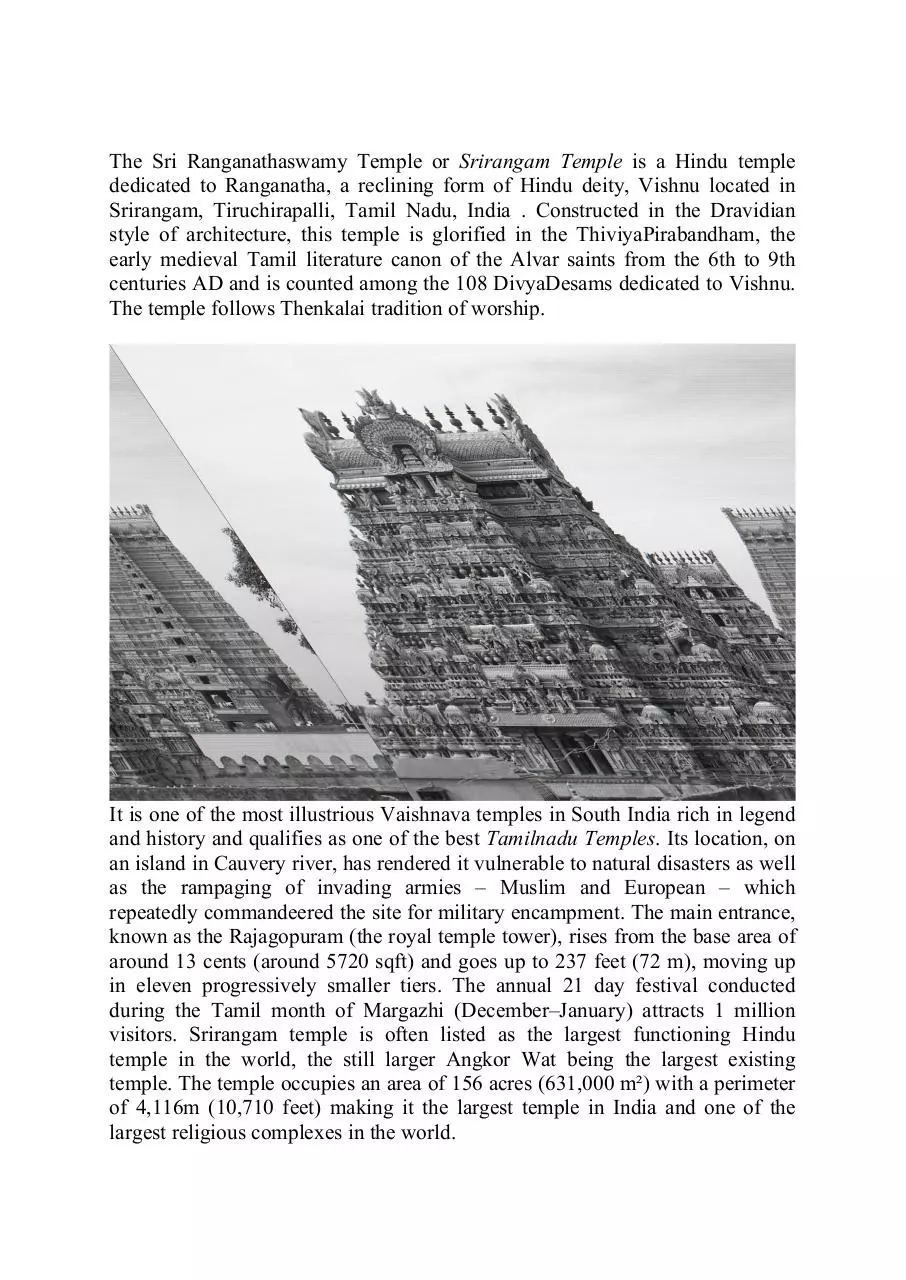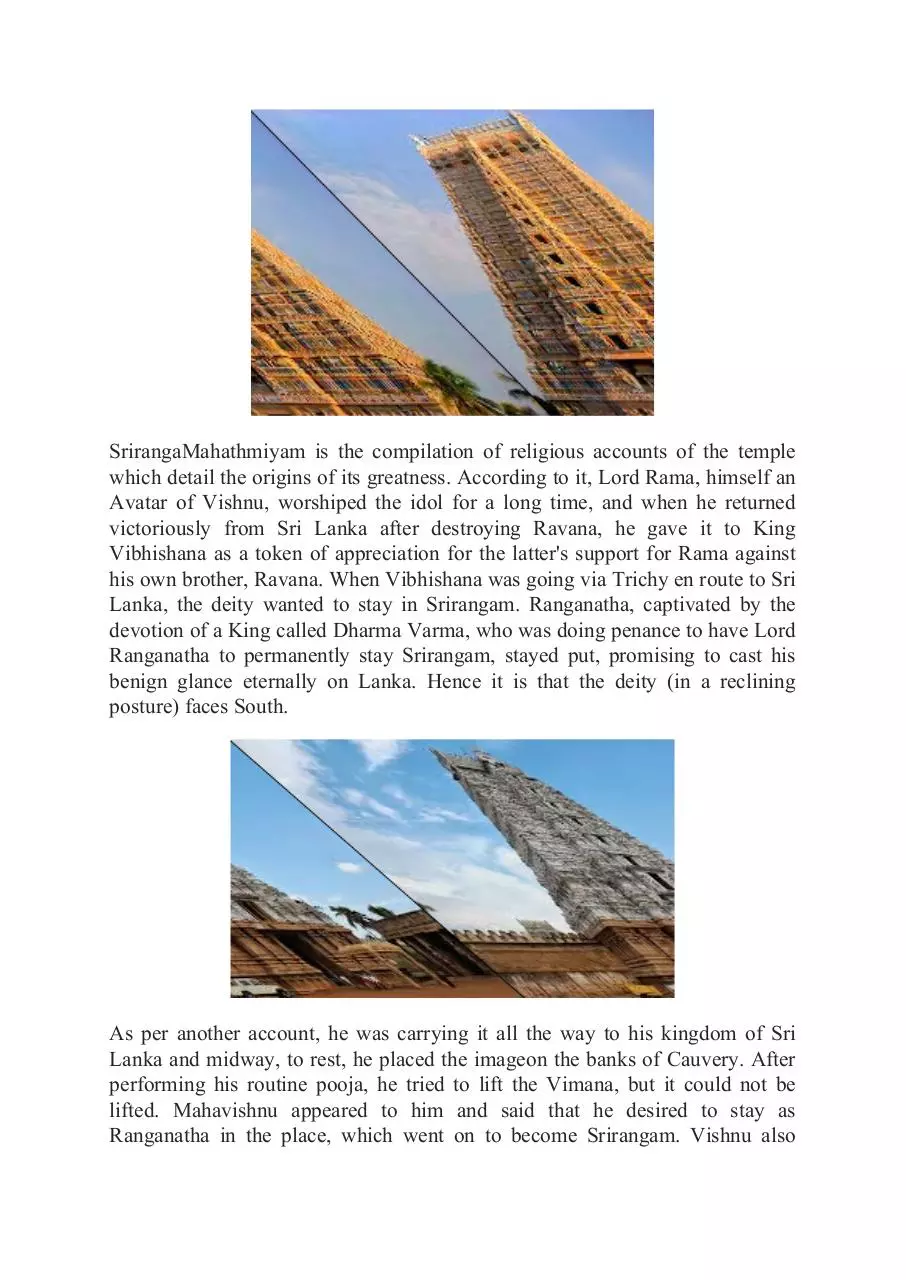Temple Article 2 (PDF)
File information
This PDF 1.5 document has been generated by , and has been sent on pdf-archive.com on 25/05/2016 at 12:15, from IP address 123.136.x.x.
The current document download page has been viewed 980 times.
File size: 2.52 MB (3 pages).
Privacy: public file



File preview
The Sri Ranganathaswamy Temple or Srirangam Temple is a Hindu temple
dedicated to Ranganatha, a reclining form of Hindu deity, Vishnu located in
Srirangam, Tiruchirapalli, Tamil Nadu, India . Constructed in the Dravidian
style of architecture, this temple is glorified in the ThiviyaPirabandham, the
early medieval Tamil literature canon of the Alvar saints from the 6th to 9th
centuries AD and is counted among the 108 DivyaDesams dedicated to Vishnu.
The temple follows Thenkalai tradition of worship.
It is one of the most illustrious Vaishnava temples in South India rich in legend
and history and qualifies as one of the best Tamilnadu Temples. Its location, on
an island in Cauvery river, has rendered it vulnerable to natural disasters as well
as the rampaging of invading armies – Muslim and European – which
repeatedly commandeered the site for military encampment. The main entrance,
known as the Rajagopuram (the royal temple tower), rises from the base area of
around 13 cents (around 5720 sqft) and goes up to 237 feet (72 m), moving up
in eleven progressively smaller tiers. The annual 21 day festival conducted
during the Tamil month of Margazhi (December–January) attracts 1 million
visitors. Srirangam temple is often listed as the largest functioning Hindu
temple in the world, the still larger Angkor Wat being the largest existing
temple. The temple occupies an area of 156 acres (631,000 m²) with a perimeter
of 4,116m (10,710 feet) making it the largest temple in India and one of the
largest religious complexes in the world.
SrirangaMahathmiyam is the compilation of religious accounts of the temple
which detail the origins of its greatness. According to it, Lord Rama, himself an
Avatar of Vishnu, worshiped the idol for a long time, and when he returned
victoriously from Sri Lanka after destroying Ravana, he gave it to King
Vibhishana as a token of appreciation for the latter's support for Rama against
his own brother, Ravana. When Vibhishana was going via Trichy en route to Sri
Lanka, the deity wanted to stay in Srirangam. Ranganatha, captivated by the
devotion of a King called Dharma Varma, who was doing penance to have Lord
Ranganatha to permanently stay Srirangam, stayed put, promising to cast his
benign glance eternally on Lanka. Hence it is that the deity (in a reclining
posture) faces South.
As per another account, he was carrying it all the way to his kingdom of Sri
Lanka and midway, to rest, he placed the imageon the banks of Cauvery. After
performing his routine pooja, he tried to lift the Vimana, but it could not be
lifted. Mahavishnu appeared to him and said that he desired to stay as
Ranganatha in the place, which went on to become Srirangam. Vishnu also
desired to watch the Brahmotsavam at Tirucherai. The festivals of the temple
are thus considered sacred.Srirangam Temple is One of the Famous Temples in
Tamilnadu.
Download Temple Article 2
Temple Article 2.pdf (PDF, 2.52 MB)
Download PDF
Share this file on social networks
Link to this page
Permanent link
Use the permanent link to the download page to share your document on Facebook, Twitter, LinkedIn, or directly with a contact by e-Mail, Messenger, Whatsapp, Line..
Short link
Use the short link to share your document on Twitter or by text message (SMS)
HTML Code
Copy the following HTML code to share your document on a Website or Blog
QR Code to this page

This file has been shared publicly by a user of PDF Archive.
Document ID: 0000376622.